PREFACE
In 2019, I wrote an article on the complex Roman port system of the city of Pisa under the title: 'The lost harbour of Pisa'. The immediate reason was a report on the reopening of the maritime museum there. Our article naturally also included a piece on the spectacular discovery of shipwrecks in the city centre.
A month ago, the digital magazine Finestre sull’Arte published a new article on these excavations by Jacopo Suggi. We did not want to withhold this article from you and therefore post it in its entirety in various languages in our digital magazine. You can also read the original story, in Italian, at: Storia del ritrovamento delle navi antiche di Pisa (finestresullarte.info)
Enjoy reading (The editors)
The story of the extraordinary discovery of the ancient ships of Pisa
by Jacopo Suggi , written on 23/07/2024
In 1998, an incredible archaeological heritage was discovered by chance near Pisa San Rossore station, destined to rewrite the history of shipping in the Tuscan city.
Pompey the Great's spell1 'navigare necesse est, vivere non est necesse' 2, with which he urged his sailors to go to sea, even if it was a raging sea, is still well-known. Over time, it has been reused numerous times as the motto of the Hanseatic League or as a derogatory statement of heroism by Italian writer Gabriele D'Annunzio (1863 -1938). More generally, it is often used to demonstrate the importance that shipping, in its dual military-commercial function, had in ancient Rome. That seafaring was a supporting force in the state, economic, social and organisational system of the time is reaffirmed by the large number of wrecks found in the depths of the sea, proving how crews were often forced to go to sea even in adverse weather conditions. However, these dramatic and unfortunate episodes are our good fortune and offer us the opportunity to learn a wealth of information about past civilisations through marine and underwater archaeology.
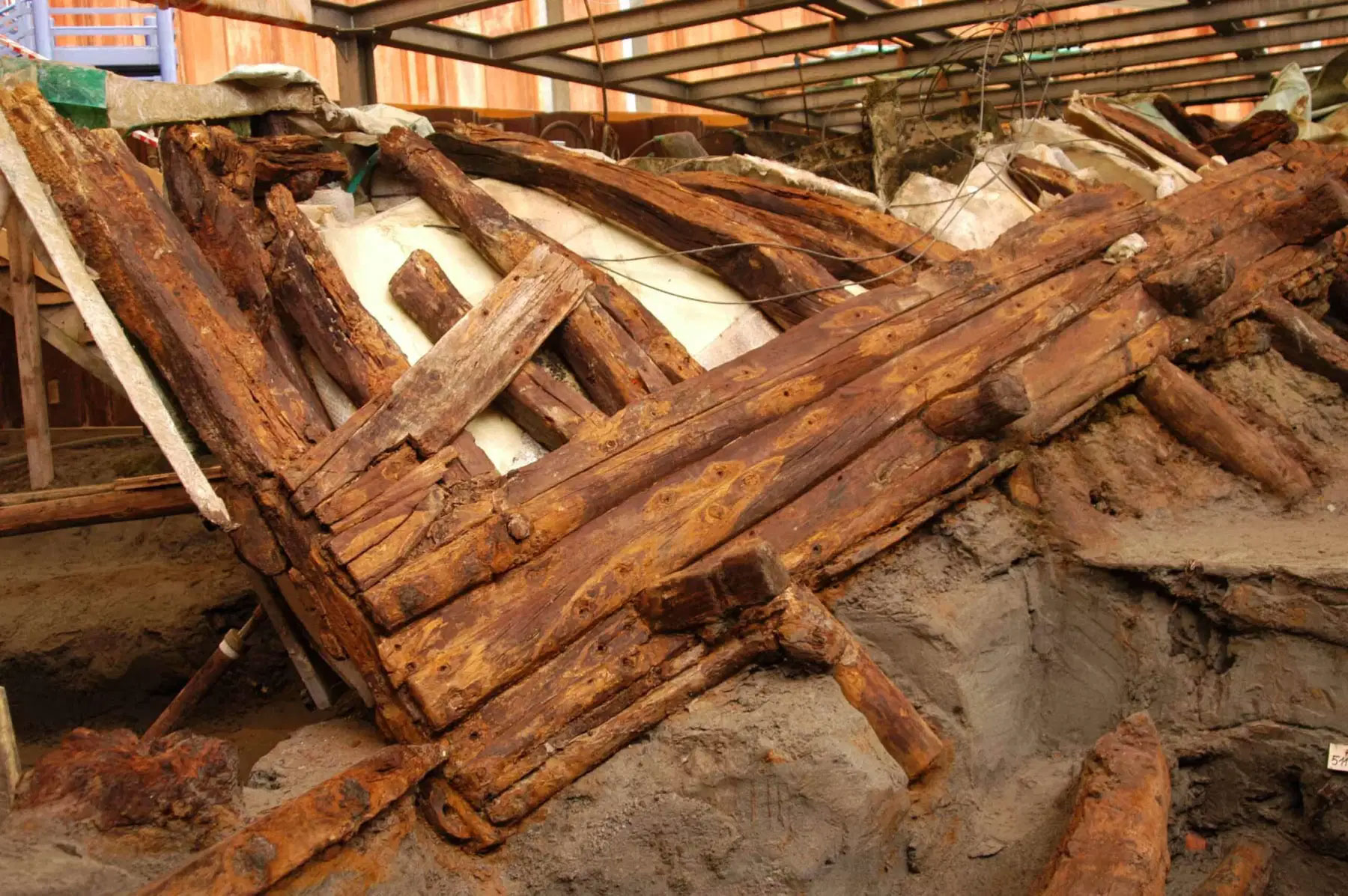
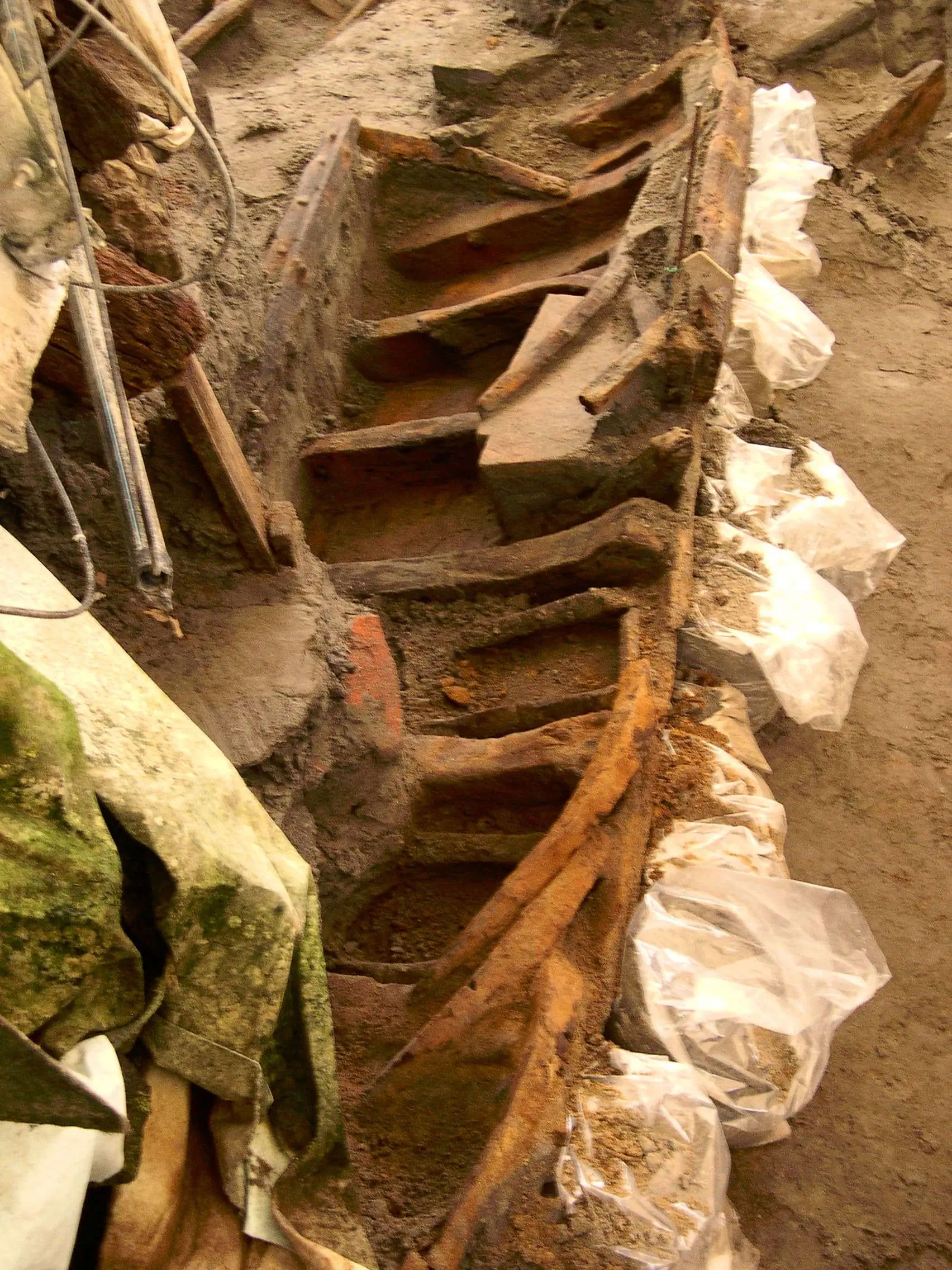
One of the most extraordinary archaeological discoveries, both quantitative and qualitative, made recently in our country is the ancient ships of Pisa, the incredible excavation that has uncovered the remains of more than 30 ships, as well as a remarkable number of finds and artefacts of various kinds, and an incalculable amount of information, so much so that someone has hyperbolically (and inappropriately) spoken of a ‘Pompeii of the sea’.
This discovery took place in 1998, during works a few hundred metres from Piazza dei Miracoli, aimed at the construction of a service building for Trenitalia, near the Pisa San Rossore station. The discovery certainly has something unexpected, but may seem surreal considering that the construction site is in the city centre about 10 kilometres from the coast. Indeed, much of Pisa's history has been intertwined with the sea, in ancient times when the coastline was much further back than today, but also later despite silting up due to the deposition of all kinds of debris thanks to the exploitation of rivers and watercourses3.
From the beginning of the excavations, at a depth of less than six metres, wooden artefacts emerged that, due to the specific environmental conditions of the site, were in a fairly good state of preservation. However, no one could have imagined what would soon come to light, and in fact the excavation was carried out in the first phase as emergency archaeology, i.e. with the aim of concentrating on the identification and recovery of artefacts in the area, and the work at the time was funded by the railways themselves. But only a few months later, people realised that what had been preserved underground was unimaginable. The enormous and exceptional quantity and quality of the finds underlined the importance of the discovery, for which it was decided as early as the summer of 1999 to proceed with an intensive construction site, creating an area for systematic research and with a design that would take much longer than initially planned.
These first finds were carried out under the guidance of first archaeologist and professor Stefano Bruni and then Andrea Camilli.
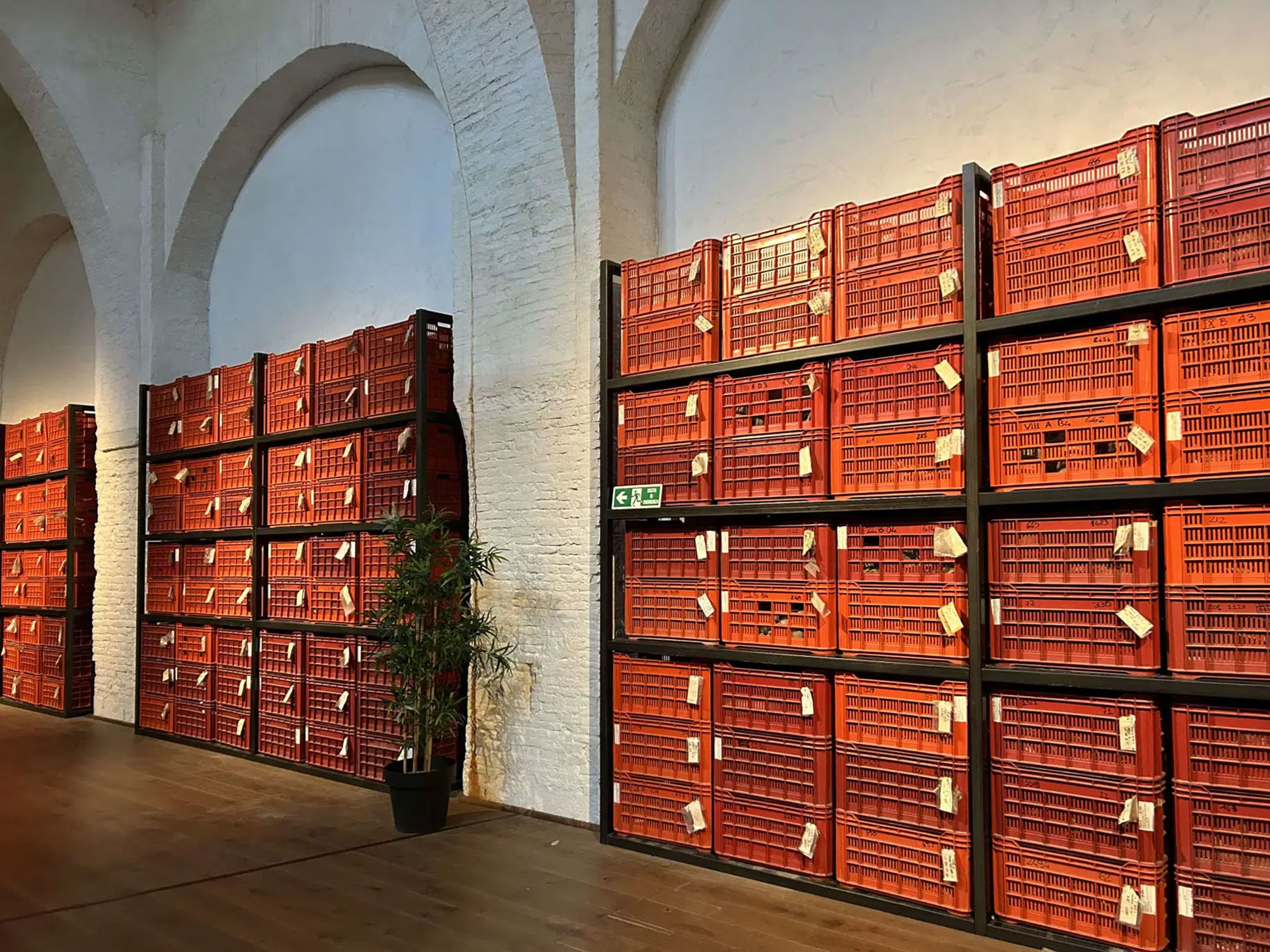
These laborious stratigraphic excavations, covering an area of more than 3,500 square metres, soon caused the Railways to abandon the planned infrastructure project, which was redeveloped as Pisa Central Station. The archaeologists involved in the research faced many problems, first of all the specific environmental problems of the area, which consists of very thick sedimentary layers and an abundant groundwater table.
To overcome the water problem, continuous use was made of mechanical pumps, while the other major difficulty, dealing with the rapid degradation and desiccation of the wooden materials found, combined with the labour-intensive requirements of a stratigraphic excavation, were overcome by opting for a ‘sectional’ excavation, i.e. uncovering only small parts of the wrecks which, once documented, were re-covered with a thin layer of fibreglass, while continuous and correct humidity was ensured by a timed irrigation system.
At the same time, it was decided to set up a restoration centre to meet the need to prepare various techniques for working on the excavated artefacts, especially for wooden artefacts, which, after washing and desalting, should be replaced by impregnating them with other inert, potentially removable substances. Thus was born the wet wood restoration workshop. This impressive deployment of forces and economies depended on the exceptionality of the find, a striking number of overlapping wrecks lying on silty and sandy shores. These are the remains of boats from different periods, swept into this deposit by the repetition of a series of powerful floods over the years.
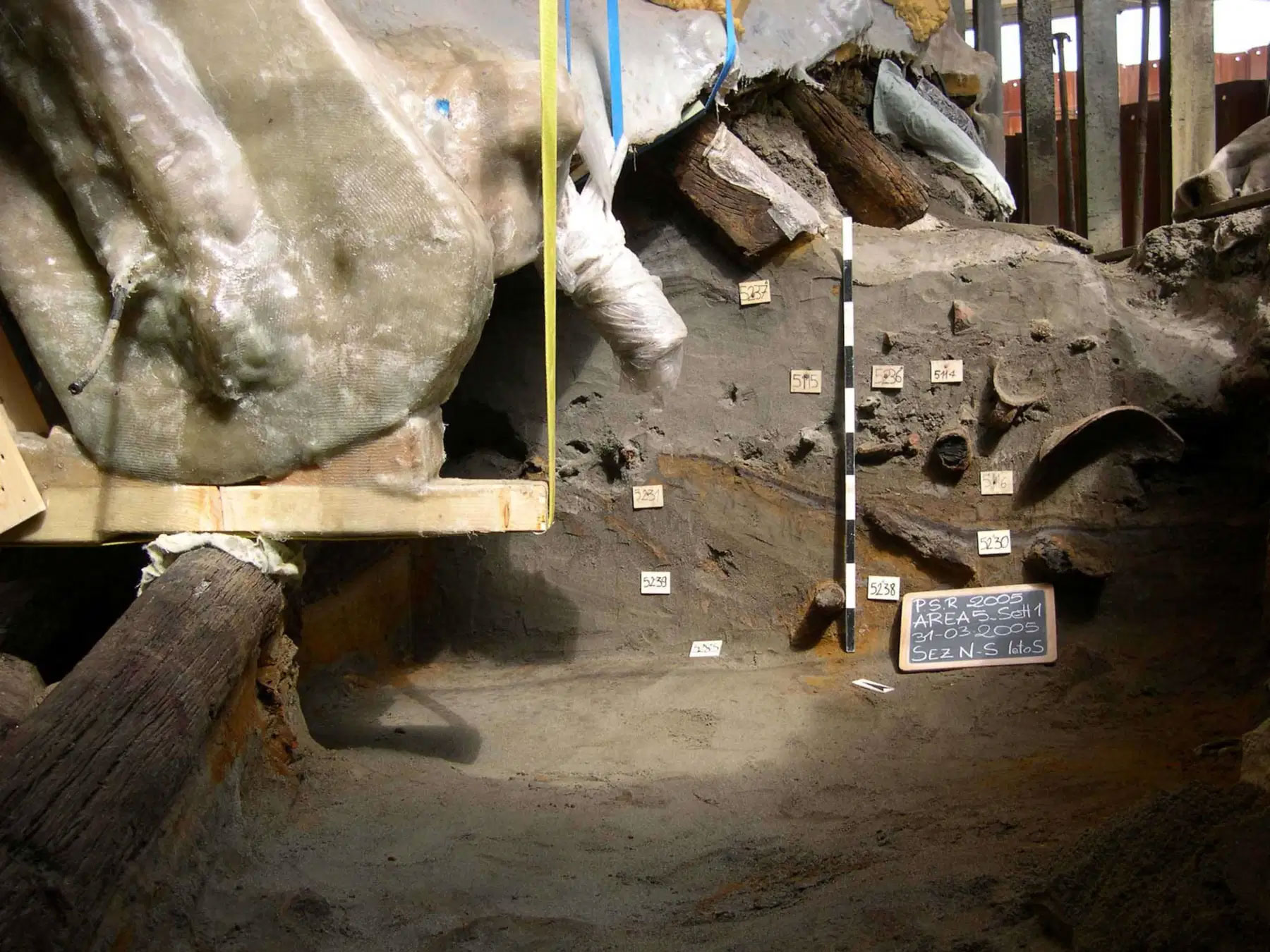
The material found, which can be dated from the Hellenistic period to late antiquity, consisted not only of the remains of ship hulls and planks, but also of a large quantity of pottery such as Greco-Italian amphorae, which was only partially assumed to be possible components of the maritime cargo of the ships present, because due to certain features of typological and chronological dissimilarity, it was hypothesised to be waste material discarded over time.
Numerous reconstruction proposals have been made on the origin of these flourishing deposits, which suggest that the settlement of Pisa in Roman times was originally built in the area of the alluvial plain of the Arno, where other watercourses also converged, including the Auser (today the Serchio). The flood hypothesis is confirmed by the discovery of at least five sets of deposits referring to traumatic natural events that sank ships.
Although accumulations of stones were found, which, according to Camilli himself, should be understood as ‘part of a layout of the riverbanks, consisting more of a rough rampart with an internal buttress than of a series of piers’, while a rectilinear wall structure may have belonged to the mooring of a manor house, the area of the excavation should therefore not be recognised as a harbour, but as a waterway, a vast roadway that was affected by heavy traffic in Roman times.
The investigation of the wreck has yielded an incredible amount of information that has made it possible to reconstruct, at least in part, its use and history. Among the remains of older ships found, one is known as a Hellenistic ship for which a dating has been assumed based on the furniture found on board, relating to the 2nd century BC. The ship must have habitually travelled on a trade route between Campania and Spain and carried various types of merchandise, including pig shoulders preserved in brine.
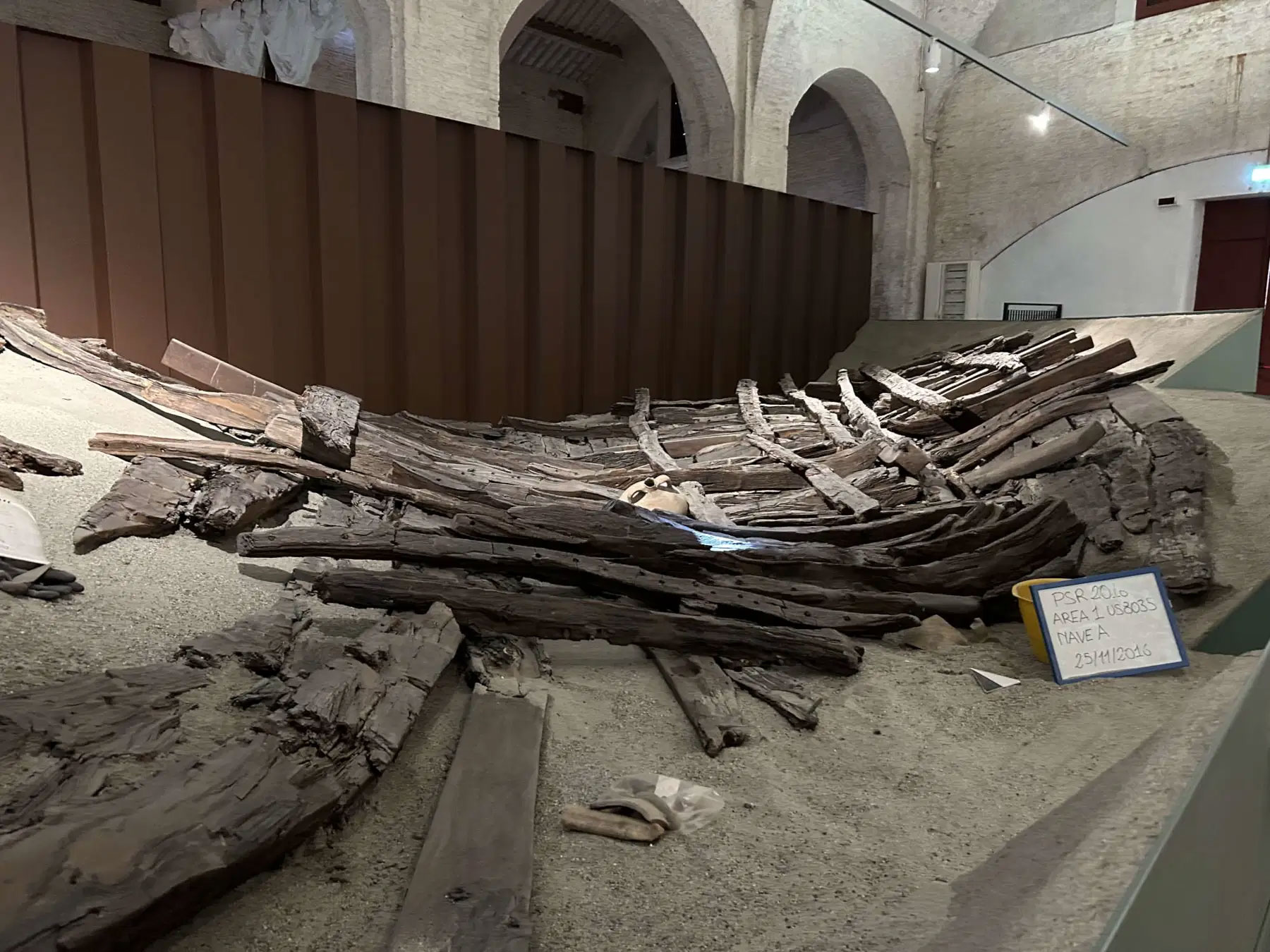
Ship A, on the other hand, was an oneraria, i.e. a large ship dedicated to trade: it must have been more than 40 metres long, although only half of it is preserved, and has been dated to the end of the 2nd century AD. Among the most prestigious pieces is a ship with 12 sails, whose tablet named Alkedo (the seagull) was also found and is among the best preserved ships. Ship I, on the contrary, is a flat-bottomed river ferry from the 5th century AD. It was pushed along the banks by a system of ropes and a winch.
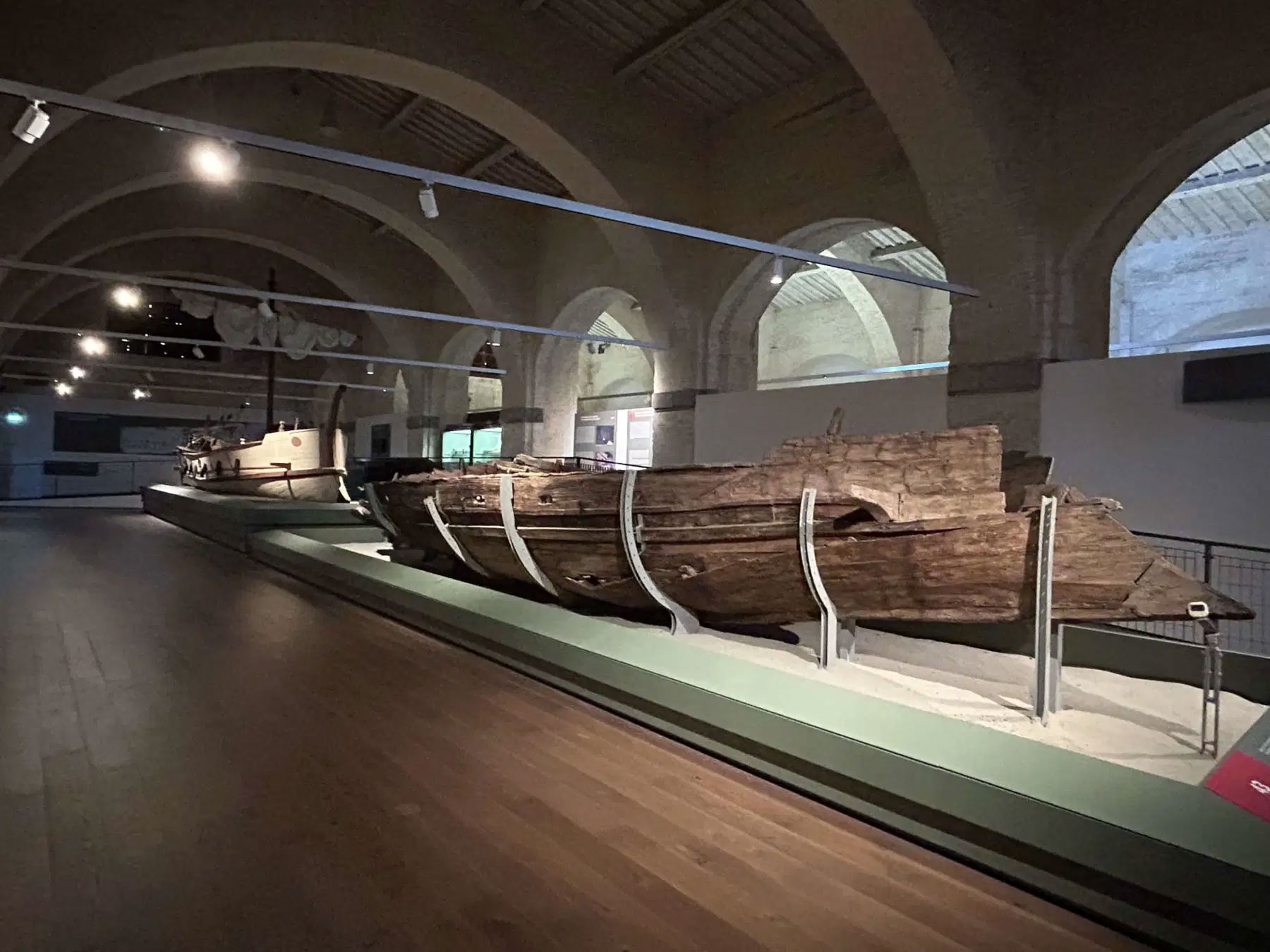
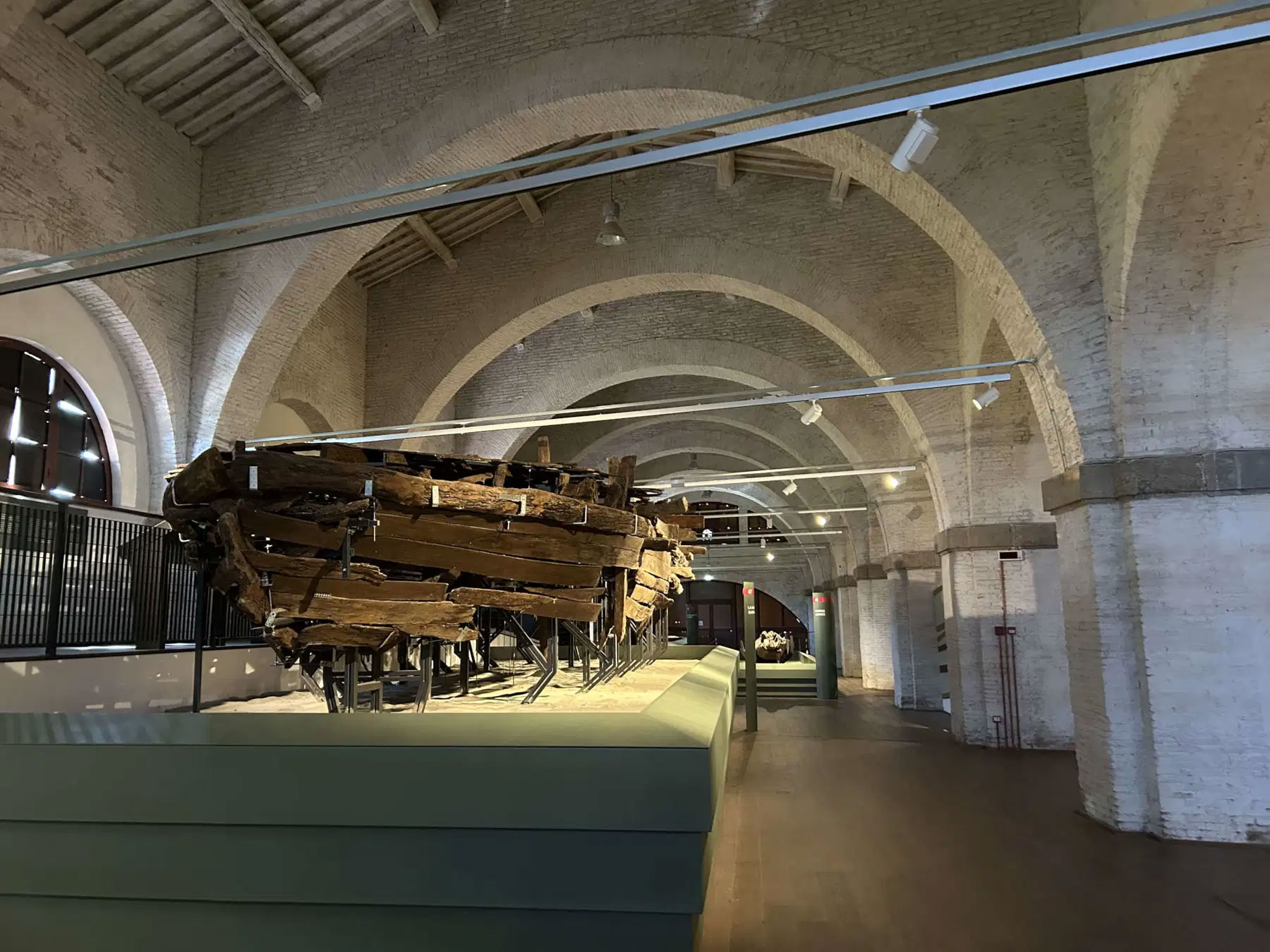
Boat D was also used on the river, a large barge that transported sand along the waterways and was either propelled by the wind thanks to a sail, whose mast is preserved, or pulled from the bank by animal power. Other finds of boat F and boat Q are of the lintres type, vessels not unlike pirogues, which were propelled by oars and could be used for small transports of goods or people. During the excavation, the remains of another 30 boats were counted, but this number was later questioned by other scholars.
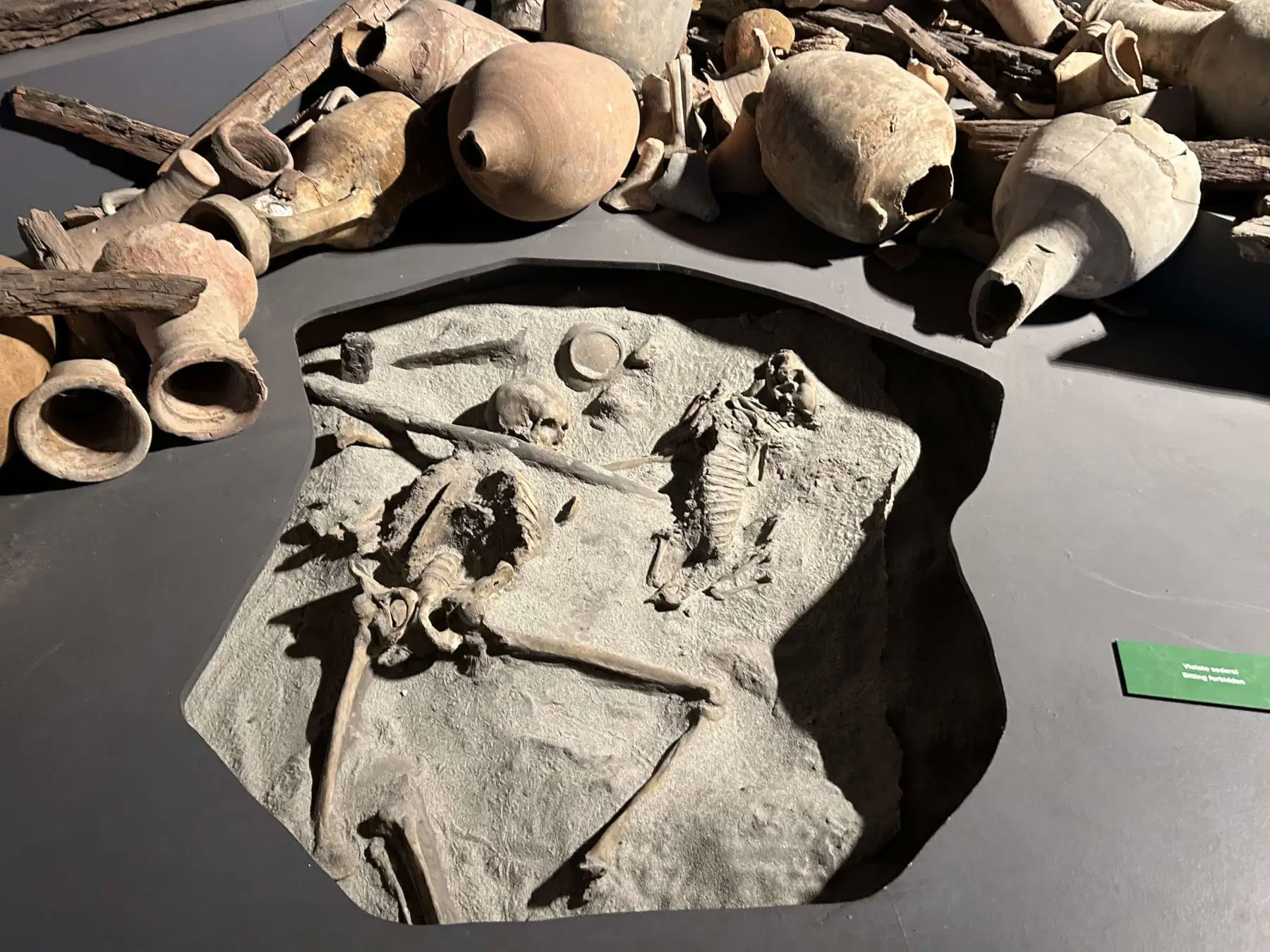
But the exceptional nature of the find was not limited to the ships and their precious cargoes. The bones of a dog and a sailor, who is believed to have sacrificed himself in an attempt to save his animal friend, were also found in the deposits. There are still numerous finds from the past, such as glassware used as glasses and balsamware destined for a luxury market, relics in wood and stone, coins, sailors' luggage and, as already mentioned, the fragments of more than 13,000 amphorae.
This groundbreaking find has made it possible and will continue to make it possible to increase our knowledge on various topics ranging from river and sea systems of ancient navigation to information on trade, contacts between population groups and the role Pisa played over the centuries.
Most of the artefacts are now part of an evocative museum trail at the Museo delle Navi Antiche di Pisa (Museum of the Ancient Ships of Pisa), which will be housed in the former Arsenali Medicei from 2019, thus recreating a parabola in time that has given the Tuscan city a close connection to the sea and shipping from ancient to modern times, revealing a more complex and richer story of the area that cannot and should not be limited to that of a medieval centre dominated by the iconic Leaning Tower.
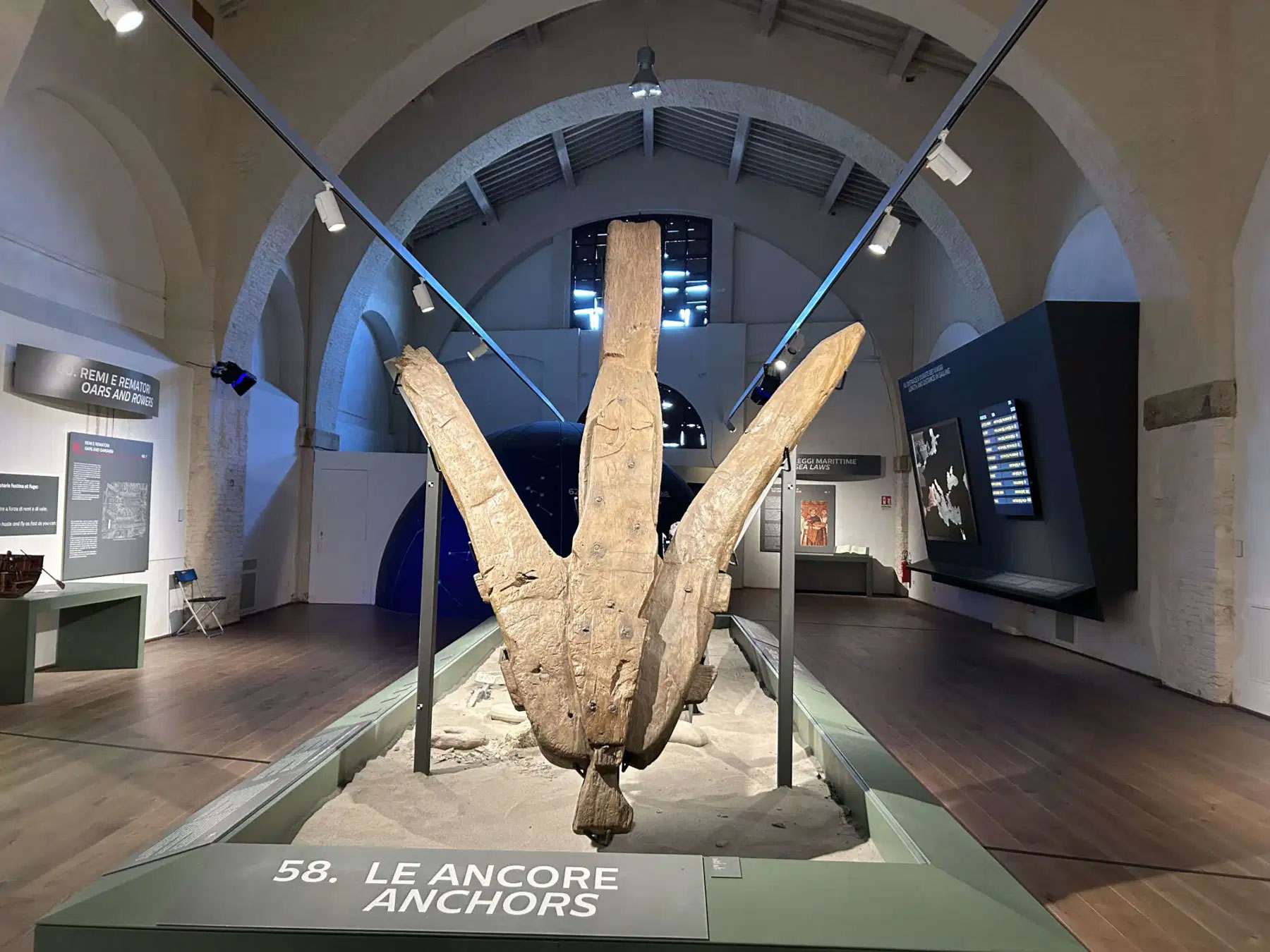
- Sources
- -Jacopo Suggi - La flotta riemersa. Storia dello straordinario ritrovamento delle navi antiche di Pisa (23/07/2024) Finestre sull’Arte
notes- 1: Gnaeus Pompeius Magnus (106 - 48 BC) - Roman soldier and consul of the Republic.
- 2: Sailing is necessary; living is not: Plutarchus {Pomp. 50) - Mentioned words of Pompey, which he is said to have spoken when he set sail from Sicily to Rome with a fleet of grain ships in stormy weather.
- 3: Read also: 'The lost harbour of Pisa' .






 We are committed to providing versions of our articles and interviews in several languages, but our first language is English.
We are committed to providing versions of our articles and interviews in several languages, but our first language is English.